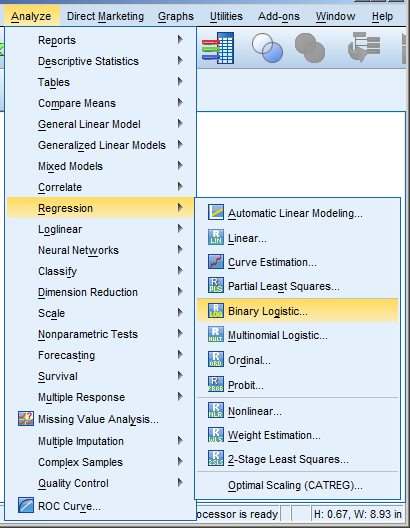Need to run a logistic regression in SPSS? Turns out, SPSS has a number of procedures for running different types of logistic regression.
Some types of logistic regression can be run in more than one procedure. For some unknown reason, some procedures produce output others don’t. So it’s helpful to be able to use more than one.
Logistic Regression
 Logistic Regression can be used only for binary dependent (more…)
Logistic Regression can be used only for binary dependent (more…)
 Someone recently asked me if they need to learn R. In responding, it struck me that this is another way that learning a stat software package is like learning a new language.
Someone recently asked me if they need to learn R. In responding, it struck me that this is another way that learning a stat software package is like learning a new language.
The metaphor is extremely helpful for deciding when and how to learn a new stat software, and to keep you going when the going gets rough. (more…)
by Lucy Fike
We know that using SPSS syntax is an easy way to organize analyses so that you can rerun them in the future without having to go through the menu commands.
Using Python with SPSS makes it much easier to do complicated programming, or even basic programming, that would be difficult to do using SPSS syntax alone. You can use scripting programming in Python to create programs that execute automatically. (more…)
I sometimes get asked questions that many people need the answer to. Here’s one about non-parametric ANOVA in SPSS.
Question:
Is there a non-parametric 3 way ANOVA out there and does SPSS have a way of doing a non-parametric anova sort of thing with one main independent variable and 2 highly influential cofactors?
Quick Answer:
No.
Detailed Answer:
There is a non-parametric one-way ANOVA: Kruskal-Wallis, and it’s available in SPSS under non-parametric tests. There is even a non-paramteric two-way ANOVA, but it doesn’t include interactions (and for the life of me, I can’t remember its name, but I remember learning it in grad school).
But there is no non-parametric factorial ANOVA, and it’s because of the nature of interactions and most non-parametrics.
What it basically comes down to is that most non-parametric tests are rank-based. In other words, (more…)
Every so often I point out to a client who exclusively uses menus in SPSS that they can (and should) hit the Paste button instead of OK. Many times, the client never realized it was there.
I am here today to tell you that it is there, and it is wonderful. For a few reasons.
When you use the menus in SPSS, you’re really taking a shortcut. You’re telling SPSS which syntax commands, along with which options, you want to run.
Clicking OK at the end of a dialog box will run the menu options you just picked. You may never see the underlying commands that SPSS just ran.
If instead you hit Paste, those command won’t automatically be run, but will instead the code to run those commands will be (more…)
I received the following email from a reader after sending out the last article: Opposite Results in Ordinal Logistic Regression—Solving a Statistical Mystery.
And I agreed I’d answer it here in case anyone else was confused.
Karen’s explanations always make the bulb light up in my brain, but not this time.
With either output,
The odds of 1 vs > 1 is exp[-2.635] = 0.07 ie unlikely to be 1, much more likely (14.3x) to be >1
The odds of £2 vs > 2 exp[-0.812] =0.44 ie somewhat unlikely to be £2, more likely (2.3x) to be >2
SAS – using the usual regression equation
If NAES increases by 1 these odds become (more…)
 Logistic Regression can be used only for binary dependent (more…)
Logistic Regression can be used only for binary dependent (more…)
